Analysis of Fluid–Structure Coupling of Sudden Water Deformation in Tunnels Under Construction
Abstract
1. Introduction
2. Research Methods
2.1. Biot’s Theory
2.2. Darcy Percolation Theory
2.3. Boundary and Initial Conditions
2.4. Model Establishment
2.4.1. Background
2.4.2. Numerical Modeling
3. Results
3.1. Model Validation and Vertical Settlement Analysis
3.2. Pore Water Pressure Changes
3.3. Changes in Surrounding Rock Stress
4. Discussion
5. Conclusions
- (1)
- The sudden flood invasion in tunnels is different from the continuous seepage behavior of rainfall in the upper part. As a seepage source, the sudden water encounter in the tunnel chamber has little effect on the width of the settlement groove due to the structural shape of the tunnel and the infiltration path of the water flow. The deformation of the surrounding rock is primarily transmitted vertically, with horizontal transmission being controllable. Significant settlement deformation persists until drainage is completed.
- (2)
- After the accumulation of water in the tunnel, the moisture state and permeability of the soil will rapidly change, and the coupling of soil and water will affect each other, manifested macroscopically as severe surface subsidence. A seepage surface emerges from the water head boundary of the cavern, extending towards the interior of the surrounding rock, where the inverted arch bottom experiences the highest pore pressure. The uppermost soil layer exhibits considerable matric suction. In clay strata characterized by low permeability, the transmission of water pressure displays time-dependent characteristics, resulting in a delay in the dissipation of pore water pressure. As the water level decreases, the flow vectors diminish, and the pore water pressure gradually stabilizes.
- (3)
- Following immersion, the saturation level of the surrounding rock and soil mass around the tunnel rises, leading to a decrease in stress and bearing capacity. As the water level drops and pore water pressure dissipates, the stress gradually recovers. However, there will still be gradual and slight soil deformation. This study provides valuable insights for the analysis of sudden water encounters in tunnels, seepage analysis originating from caverns, and disaster control measures.
Author Contributions
Funding
Data Availability Statement
Conflicts of Interest
References
- Peng, T. Characteristics of Seepage Field in an Underground Engineering Area and Analysis of Water Source of Structural Leakage. J. Acta Geologica Sichuan 2020, 40, 98–102. [Google Scholar]
- Lu, C.Y. Study on Failure Behavior of SDDC Artificial Foundation due to Water Permeation. Master’s Thesis, Xi’an University of Architecture and Technology, Xi’an, China, 2019. [Google Scholar]
- Wang, X.F.; Wu, J.H.; Wang, Y.L. Test on Soil Deformation Caused by Water Pumping and Artificial Recharge. J. Eng. Geol. 2016, 24, 1161–1167. [Google Scholar]
- Zheng, J.J.; Zhao, K. Influence on Stability of Loess Subway Tunnel in Flooded Surrounding Rock. J. China Railw. Soc. 2011, 33, 91–95. [Google Scholar]
- Wang, Y.; Zheng, S.; Li, Y.; Wang, Y.; Huang, Y. The failure characteristics around shallow buried tunnels under rainfall conditions. Geomat. Nat. Hazards Risk 2021, 12, 363–380. [Google Scholar] [CrossRef]
- Tao, D. Study on the Mechanical Behavior of Construction of Shallow Shield Tunnel and Influence of Local Groundwater Immesion. Master’s Thesis, Anhui Jianzhu University, Hefei, China, 2021. [Google Scholar]
- Liu, Y.; Chen, H.; Zhang, L.; Wang, X. Risk prediction and diagnosis of water seepage in operational shield tunnels based on random forest. J. Civ. Eng. Manag. 2021, 27, 539–552. [Google Scholar] [CrossRef]
- Yan, Q.; Li, Y.; Yuan, Y. Research on the Evolution Mechanism of Large Deformation of Expansive Loess Tunnel under Rainfall. J. Math. Probl. Eng. 2022, 2022, 9930738. [Google Scholar] [CrossRef]
- Bezuijen, A. Keynote Lecture: Soil-water-tunnel interaction at the front face of a TBM. In Geotechnics for Sustainable Infrastructure Development; Springer: Singapore, 2020; pp. 207–220. [Google Scholar]
- Kavvadas, M.; Litsas, D.; Vazaios, I.; Fortsakis, P. Development of a 3D finite element model for shield EPB tunnelling. Tunn. Undergr. Space Technol. 2017, 65, 22–34. [Google Scholar] [CrossRef]
- Xie, W. Impact analysis of rainfall infiltration on the deformation mechanism and stability of roadbed slope. J. Xi’an Univ. Archit. Technol. 2020, 52, 470–477. [Google Scholar]
- Guo, Z.S. A Thesis Submitted in Partial Fulfilment of the Requirements for the Degree of Master of Engineering. Master’s Thesis, Huazhong University of Science and Technology, Wuhan, China, 2016. [Google Scholar]
- Zhang, Z.; Huang, M.; Pan, Y.; Li, Z.; Ma, S.; Zhang, Y. Time-dependent analyses for ground movement and stress field induced by tunnelling considering rainfall infiltration mechanics. J. Tunn. Undergr. Space Technol. 2022, 122, 104378. [Google Scholar] [CrossRef]
- Zhao, Y.; Meng, R.; Wei, H.; Qing, Y. Analysis of tunnel collapse mechanism and grouting reinforcement measures under the unsaturated seepage effect. J. Chin. Harb. Eng. 2022, 42, 11–15. [Google Scholar] [CrossRef]
- Li, H.; He, Y.; Fan, G.; Li, T.; Pastor, M. Recent developments of generalized plasticity models for saturated and unsaturated soils. J. Water Sci. Eng. 2011, 4, 329–344. [Google Scholar]
- Luo, Z.; Zeng, F. Finite element numerical simulation of land subsidence and groundwater exploitation based on visco-elasticplastic Biot’s consolidation theory. J. Hydrodyn. 2011, 23, 615–624. [Google Scholar] [CrossRef]
- Wang, Z.N. Stress-Strain Characteristics and Settlement control of soil During Tunnel Excavation Reinforced by Clay Shock Method. Master’s Thesis, North China University of Water Resources and Electric Power, Zhengzhou, China, 2022. [Google Scholar]
- Liu, H.R. Study on the Influence Applied to Surrounding Environment Induced by the Shield Construction of Zhengzhou Metro. Master’s Thesis, Henan University of Technology, Zhengzhou, China, 2016. [Google Scholar]
- Wang, B.G.; Bi, Y.T.; Tan, X.J.; Zhu, P.J.; Hou, R.B. Numerical and experimental analysis of shield tunnels with super-close oblique crossing over existing tunnel. J. Geotech. Investig. Surv. 2023, 51, 1–7+20. [Google Scholar]
- Du, M.F.; Man, J.Q.; Yi, L.B.; Zhu, D.D. Study on the Impact of Underpass Construction at Different Diagonal Intersection Angles in a Shield Tunnel Section of Zhengzhou Metro on Railways. J. Mod. Tunn. Technol. 2020, 57, 466–472. [Google Scholar] [CrossRef]
- Yu, L.P. Analysis of Soil’s Elastic Modulus Values Based on FLAC3D Simulation. J. Water Resour. Archit. Eng. 2010, 66, 135–136. [Google Scholar]
- Song, J.; Miao, L.; Dai, S.; Ma, Y. 3D coupled mechanical and hydraulic analysis of pore water pressure disturbed by shield tunnelling. Chin. J. Geotech. Eng. 2013, 35, 302–312. [Google Scholar]
- Zhou, J.; Shi, D.D.; Jia, M.C.; Cui, J.H. In-situ test study on low-energy dynamic consolidation method to improve a silty clay ground. Rock Soil Mech. 2007, 28, 2359–2364. [Google Scholar] [CrossRef]
- Fredlund, D.G.; Morgenstern, N.R.; Widger, R.A. The shear strength of unsaturated soils. Can. Geotech. J. 1978, 15, 313–321. [Google Scholar] [CrossRef]
- Liu, W.; Liang, J.; Xu, T. Tunnelling-induced ground deformation subjected to the behavior of tail grouting materials. Tunn. Undergr. Space Technol. 2023, 140, 105253. [Google Scholar] [CrossRef]
- Liang, J.; Liu, W.; Yin, X.; Li, W.; Yang, Z.; Yang, J. Experimental study on the performance of shield tunnel tail grout in ground. Undergr. Space 2025, 20, 277–292. [Google Scholar] [CrossRef]
- Dong, W.; Huang, H.; Zhong, M.; Wang, H.; Hua, F. Monitoring and early warning mechanism of flood invasion into subway tunnels based on the experimental study of flooding patterns. J. Intell. Constr. 2024, 22, 9180011. [Google Scholar] [CrossRef]

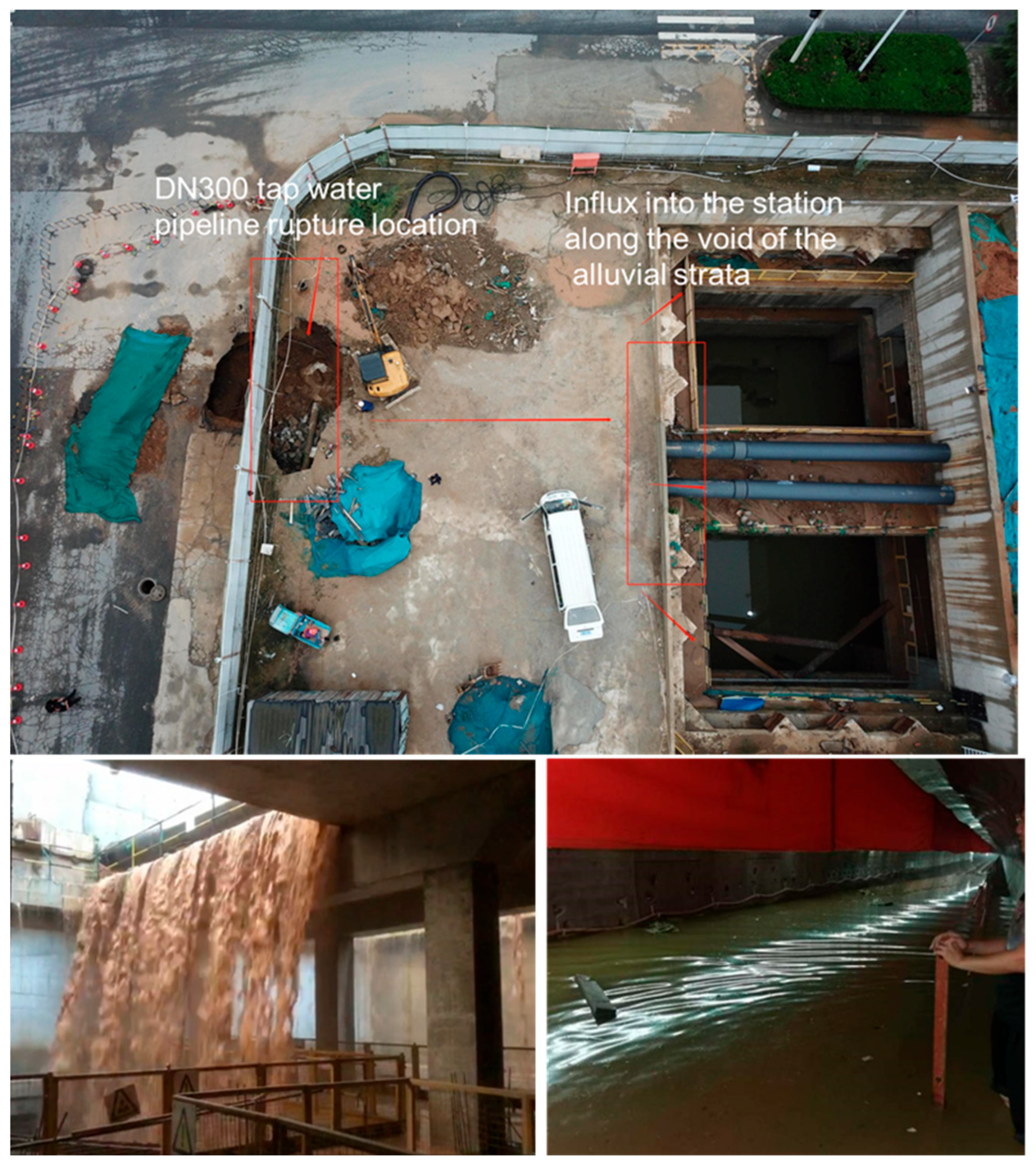
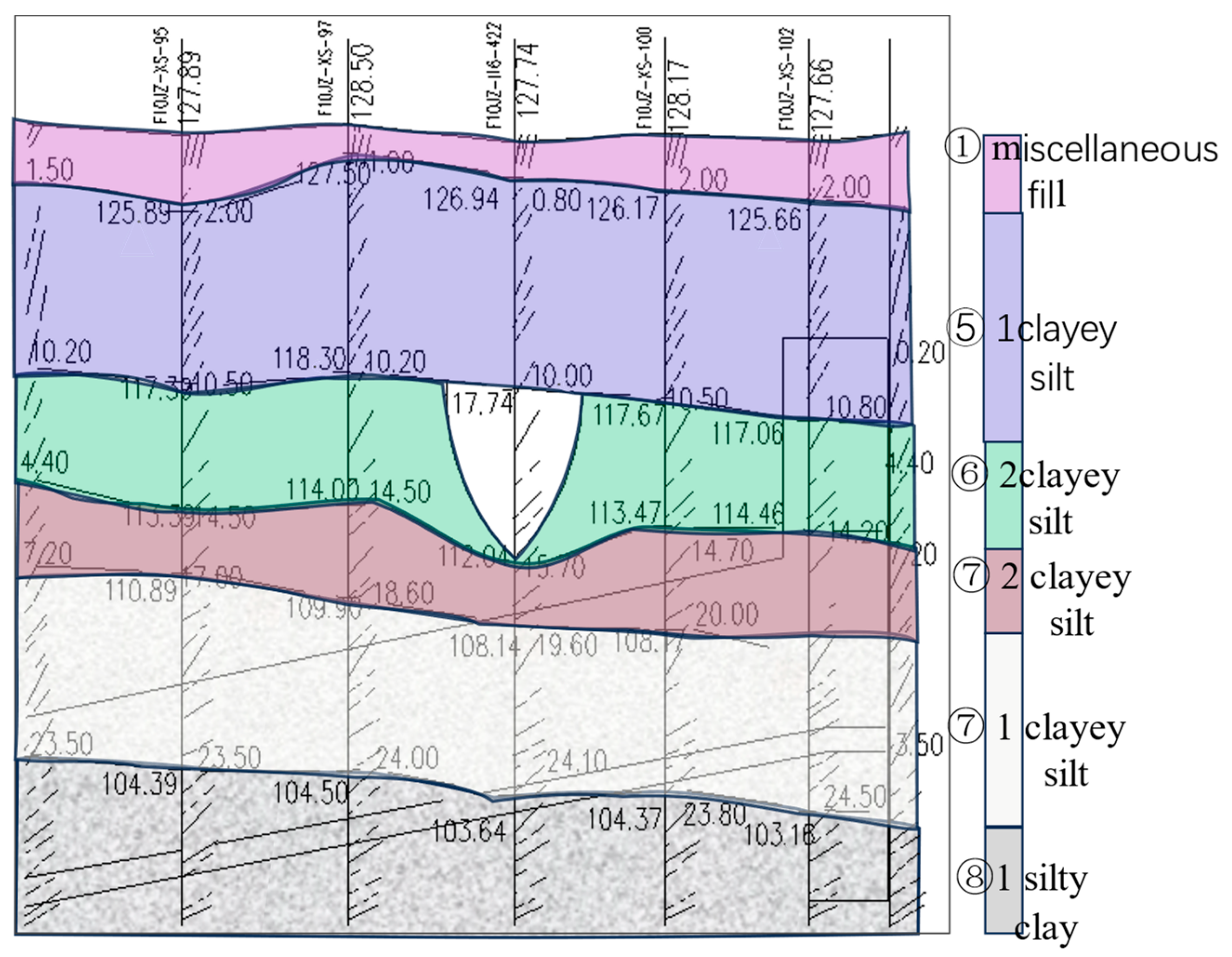
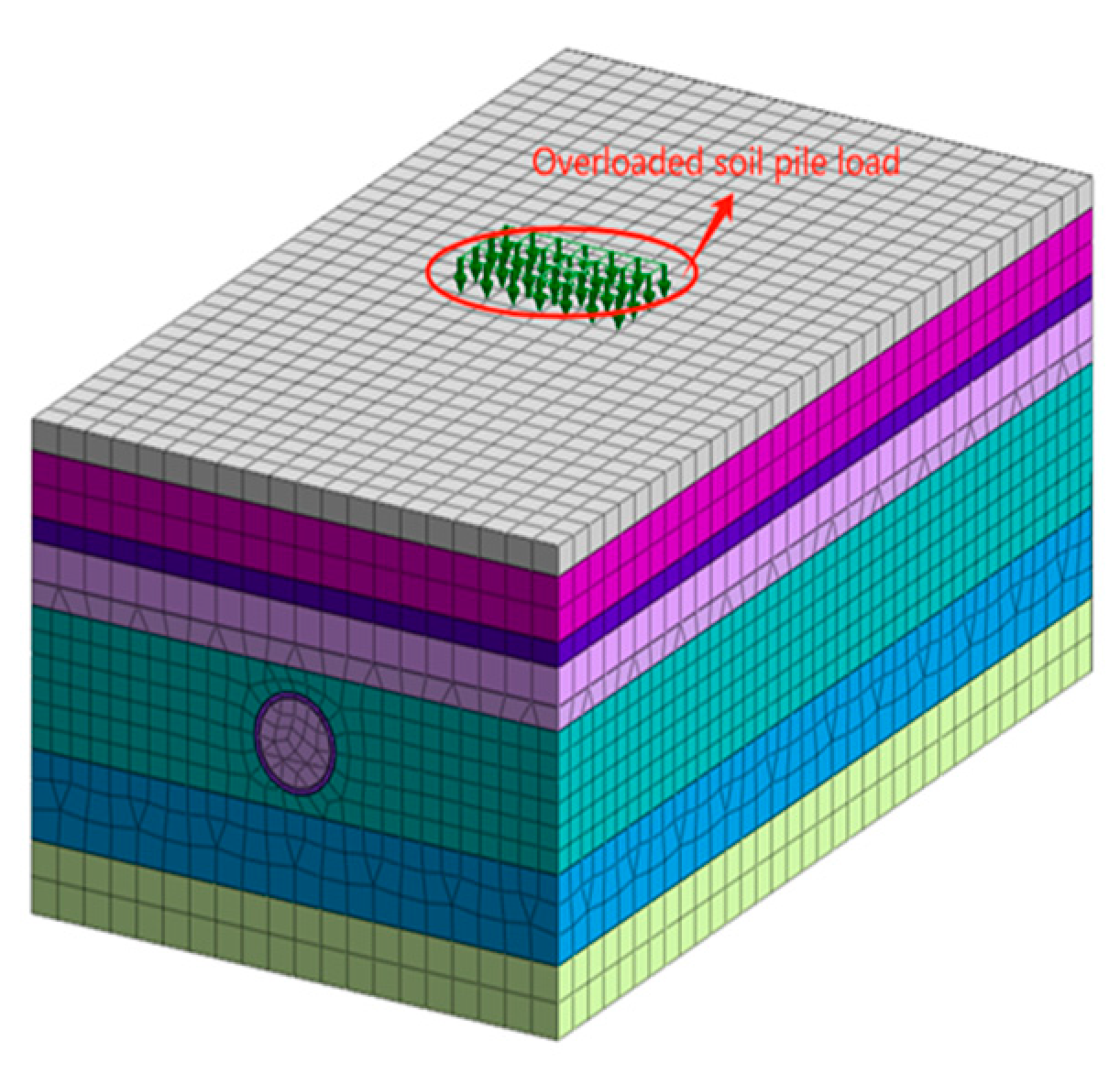
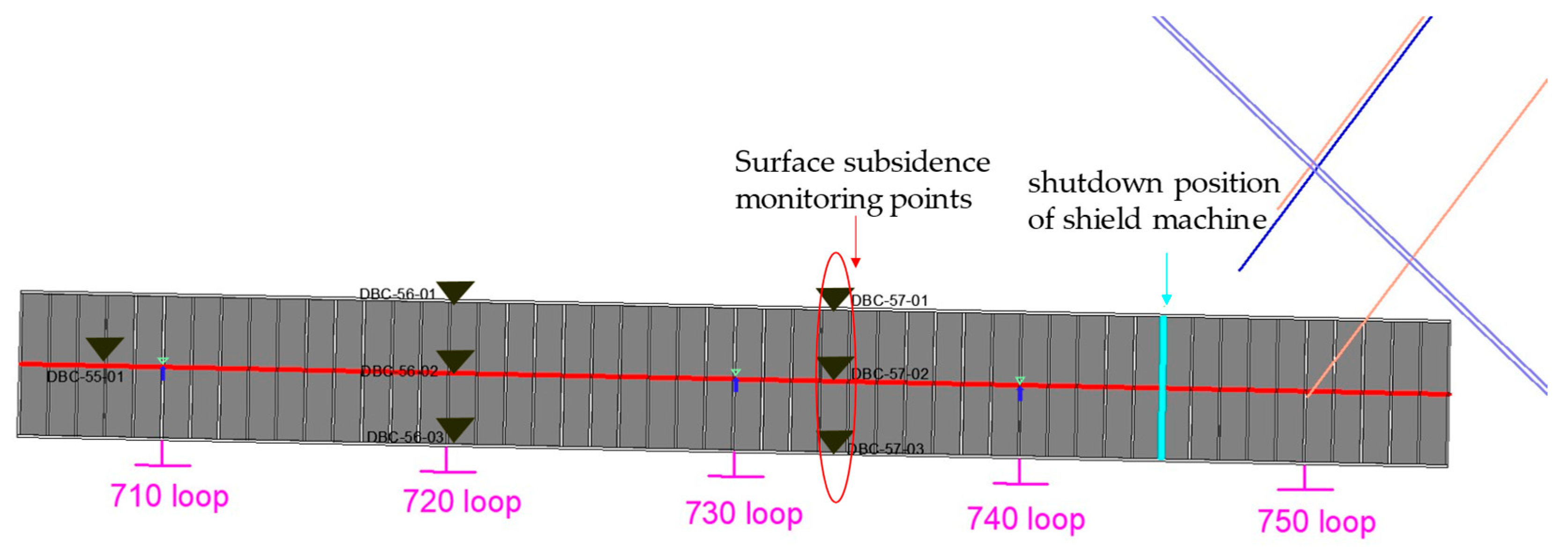
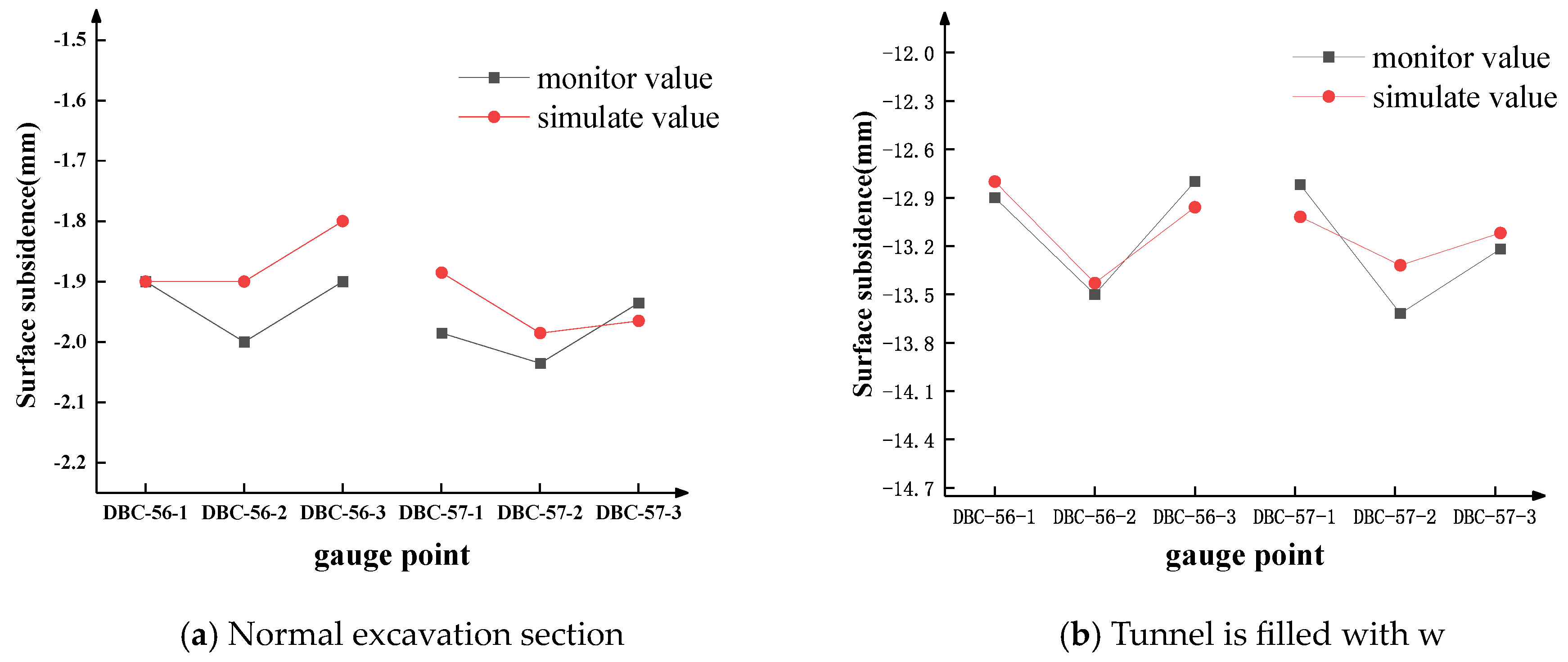

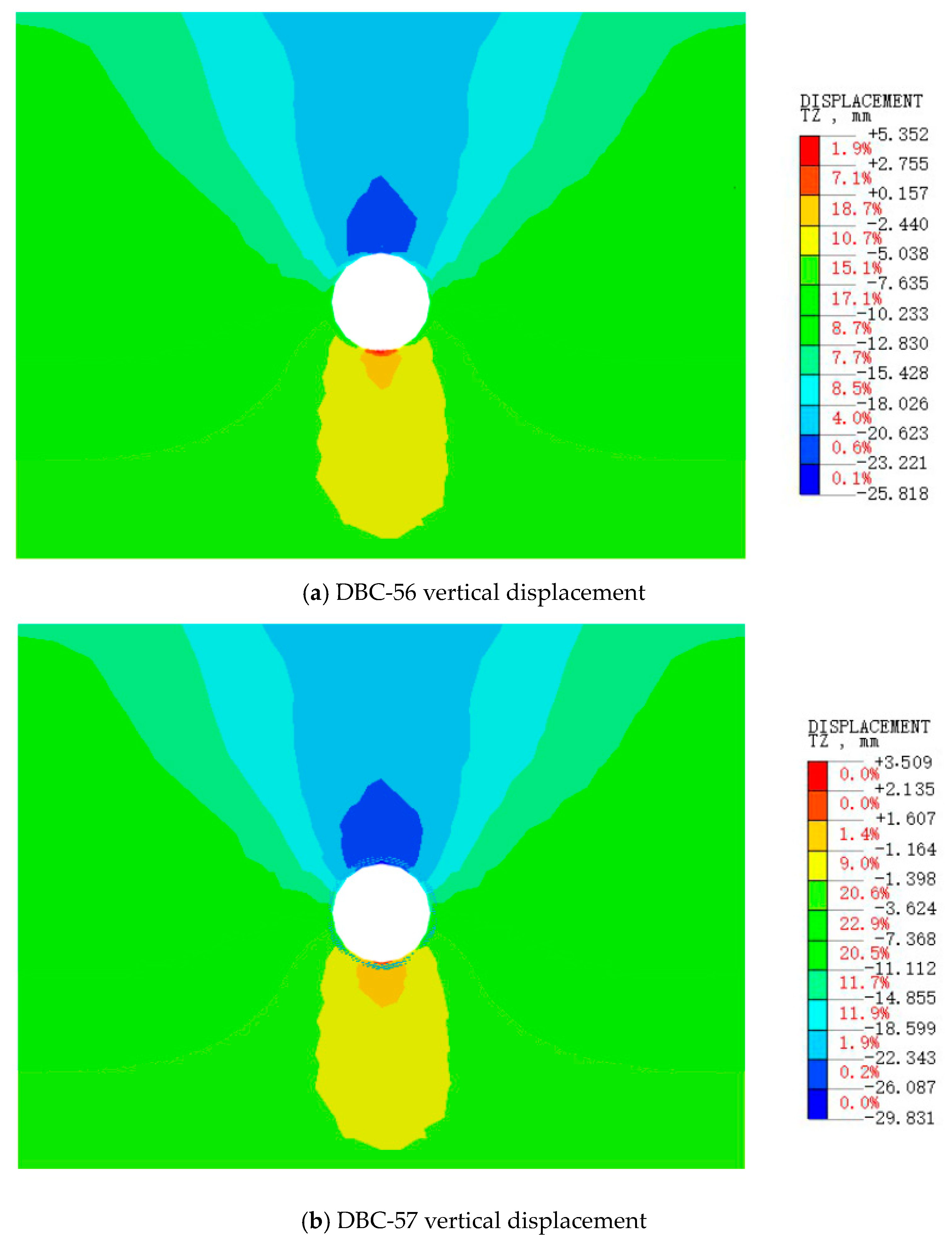
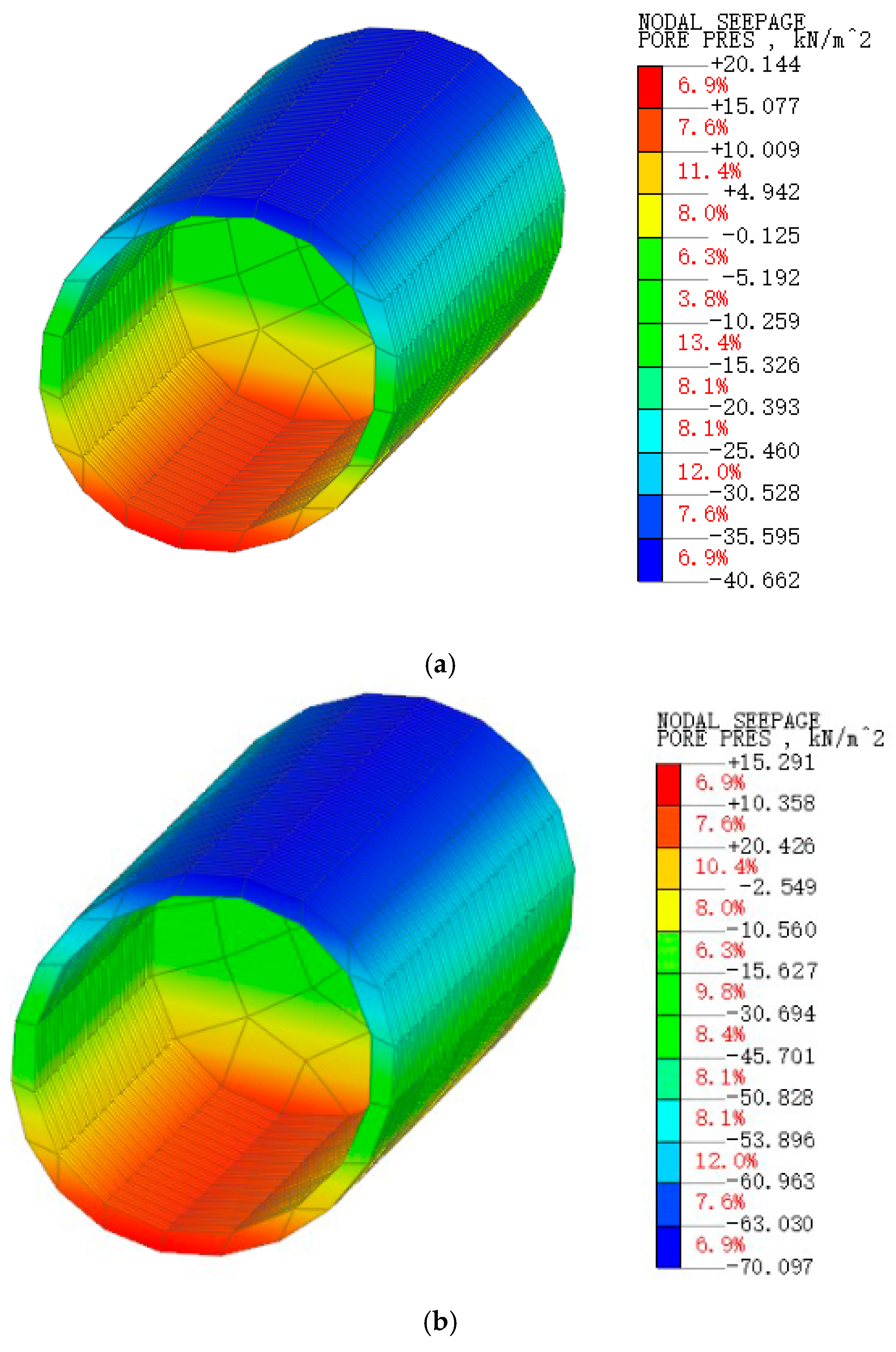
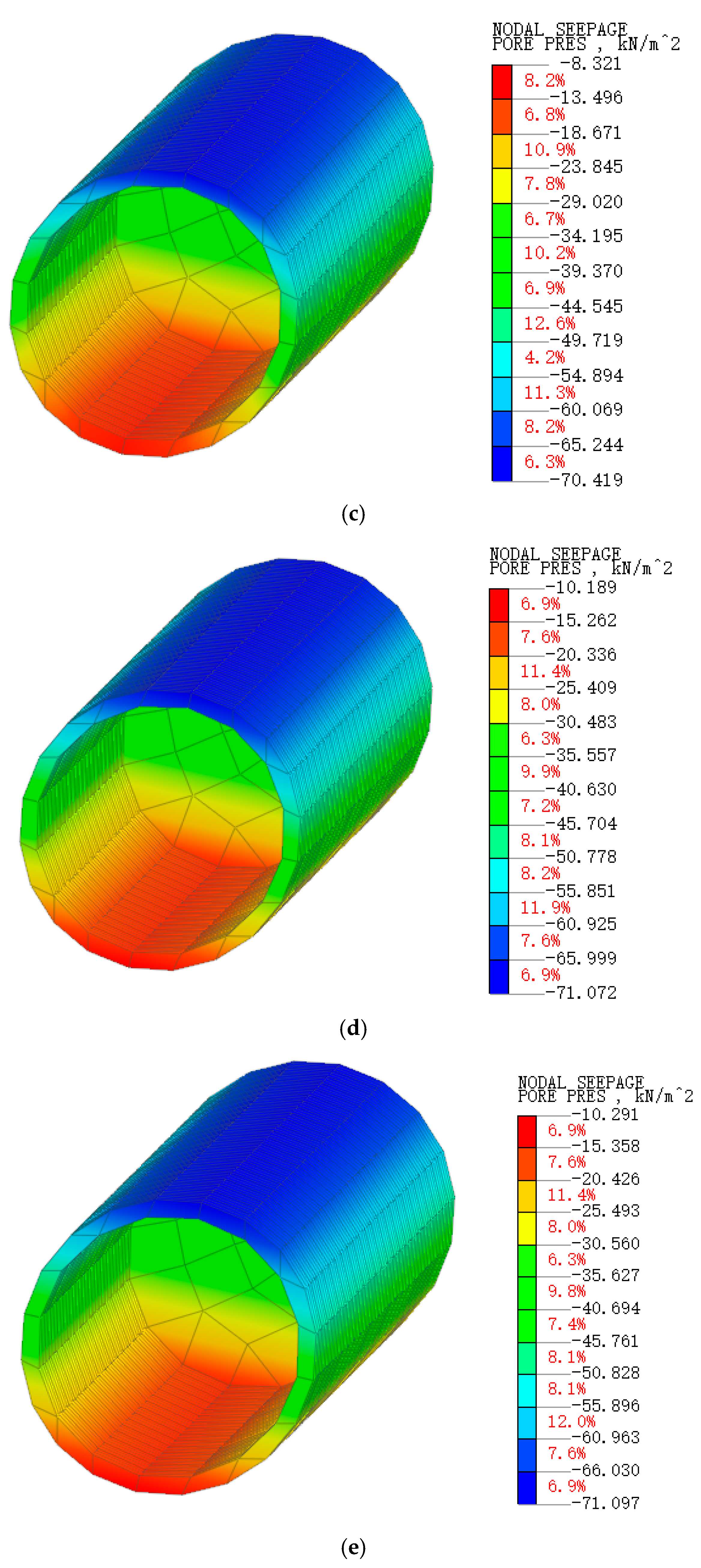
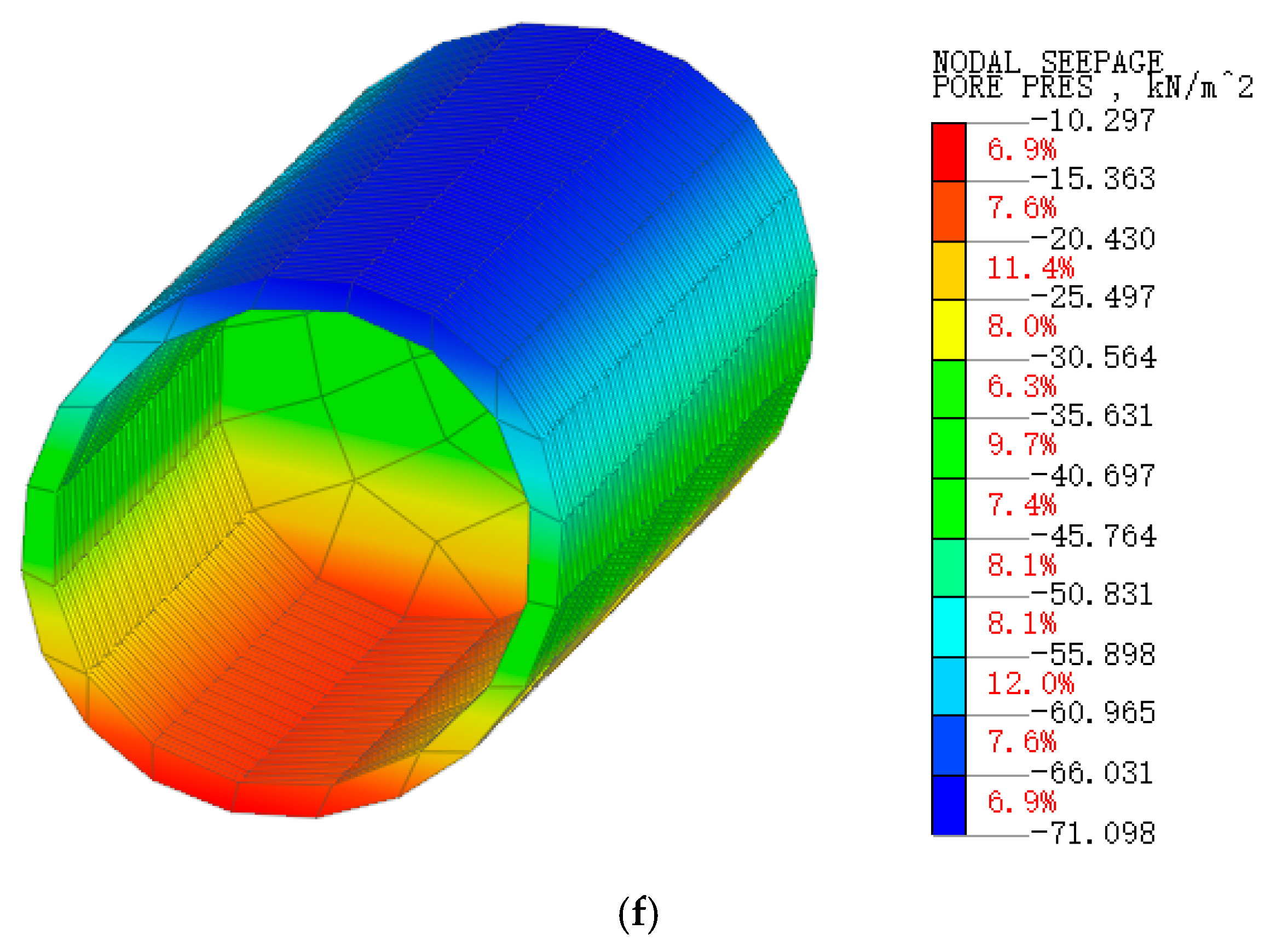
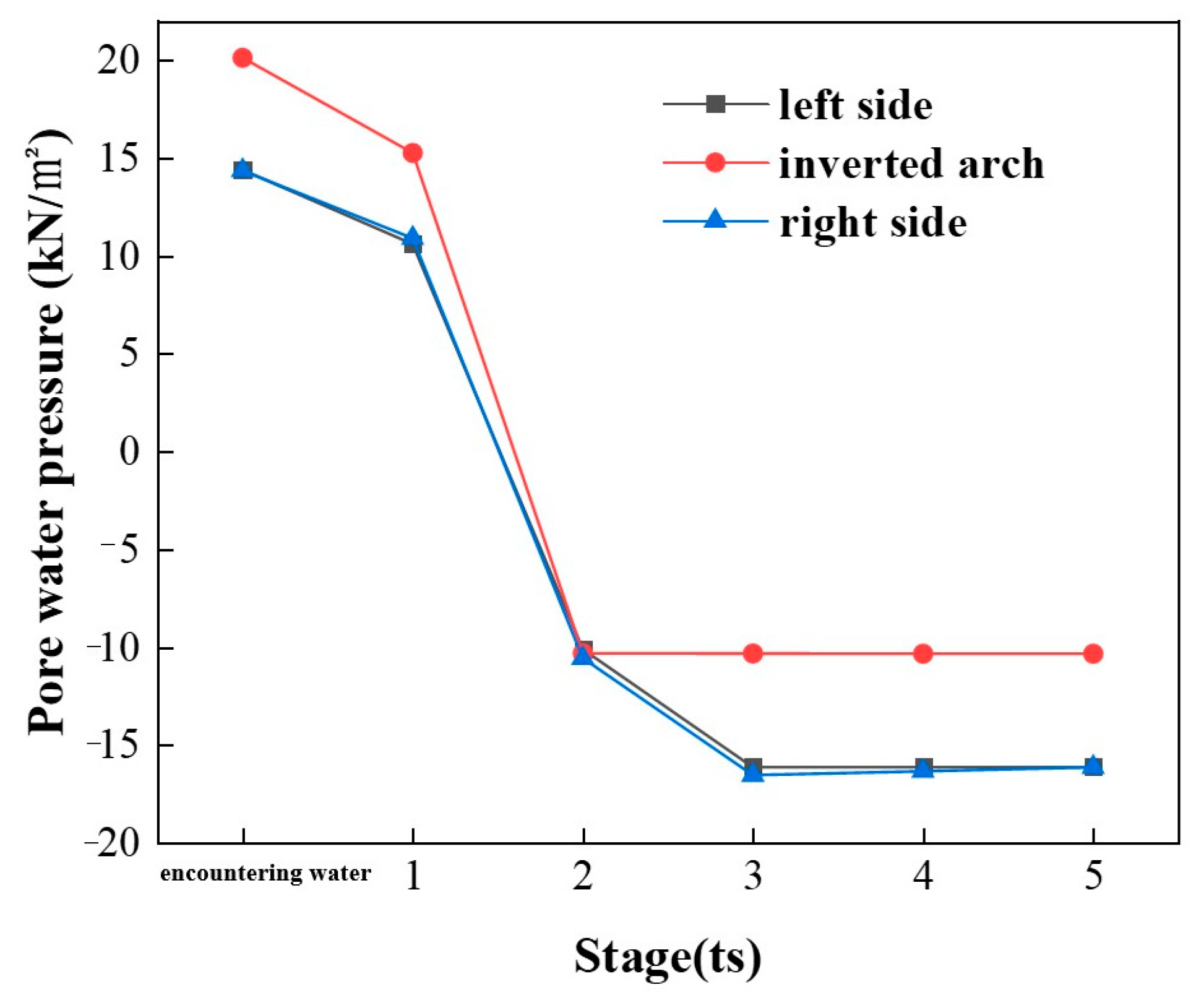
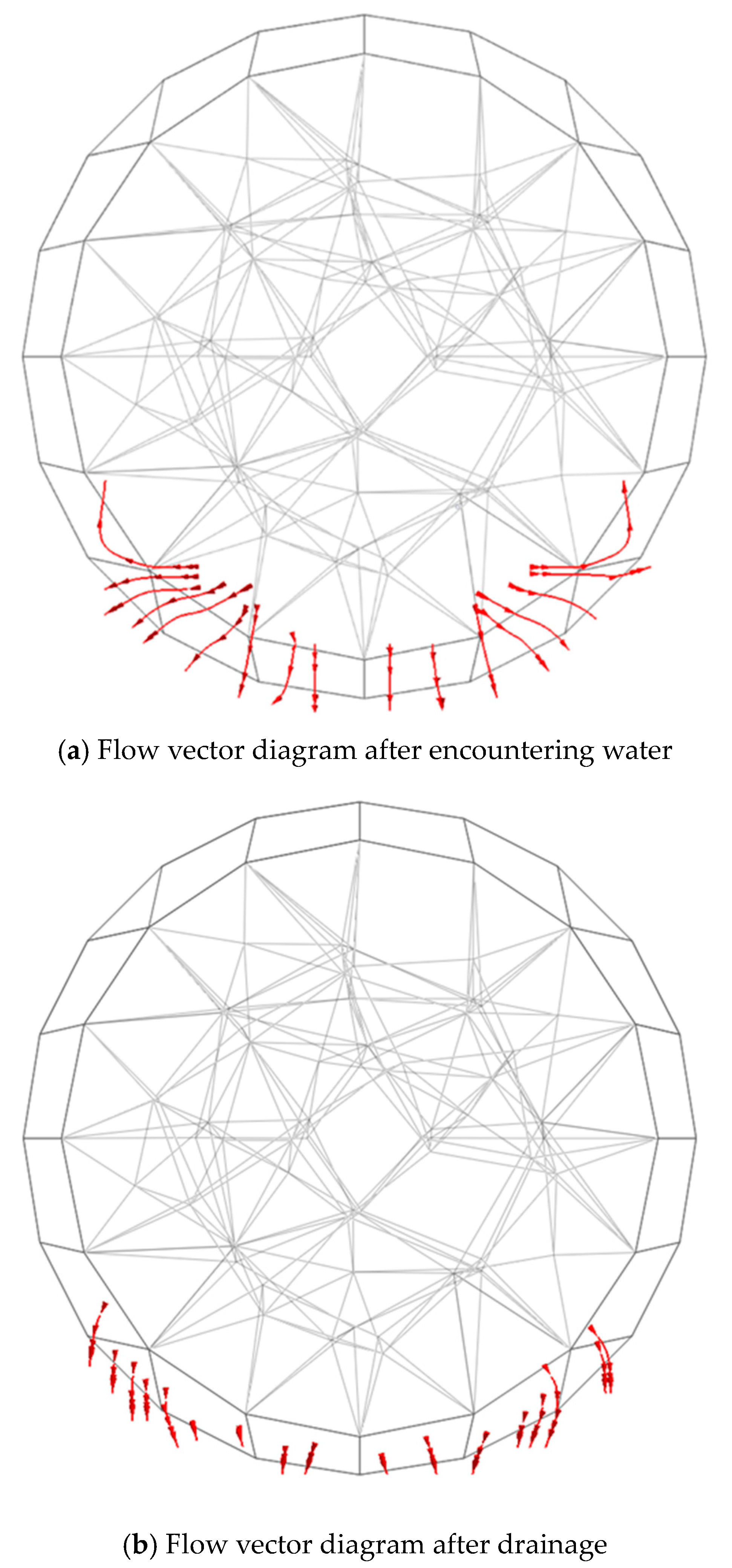
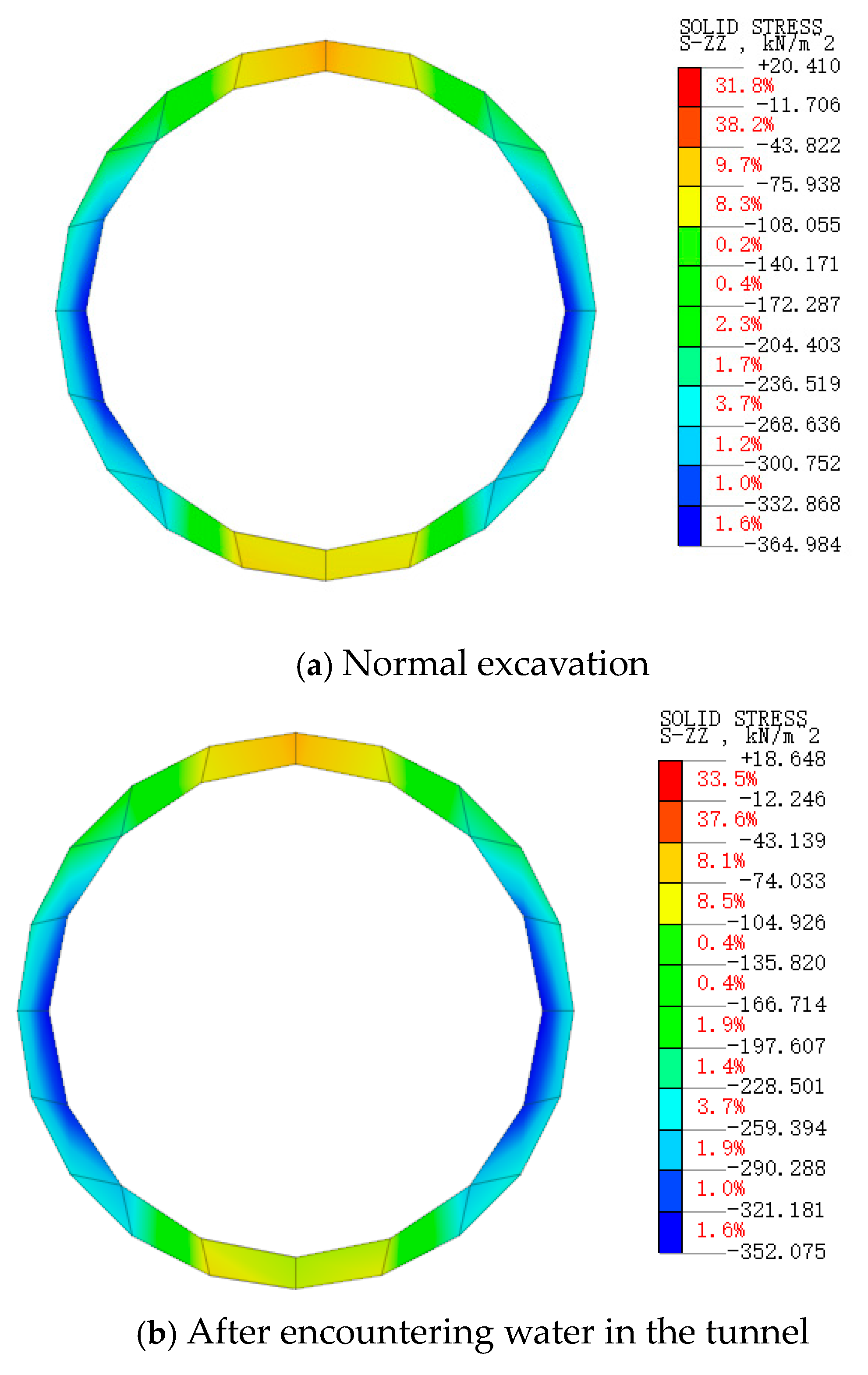
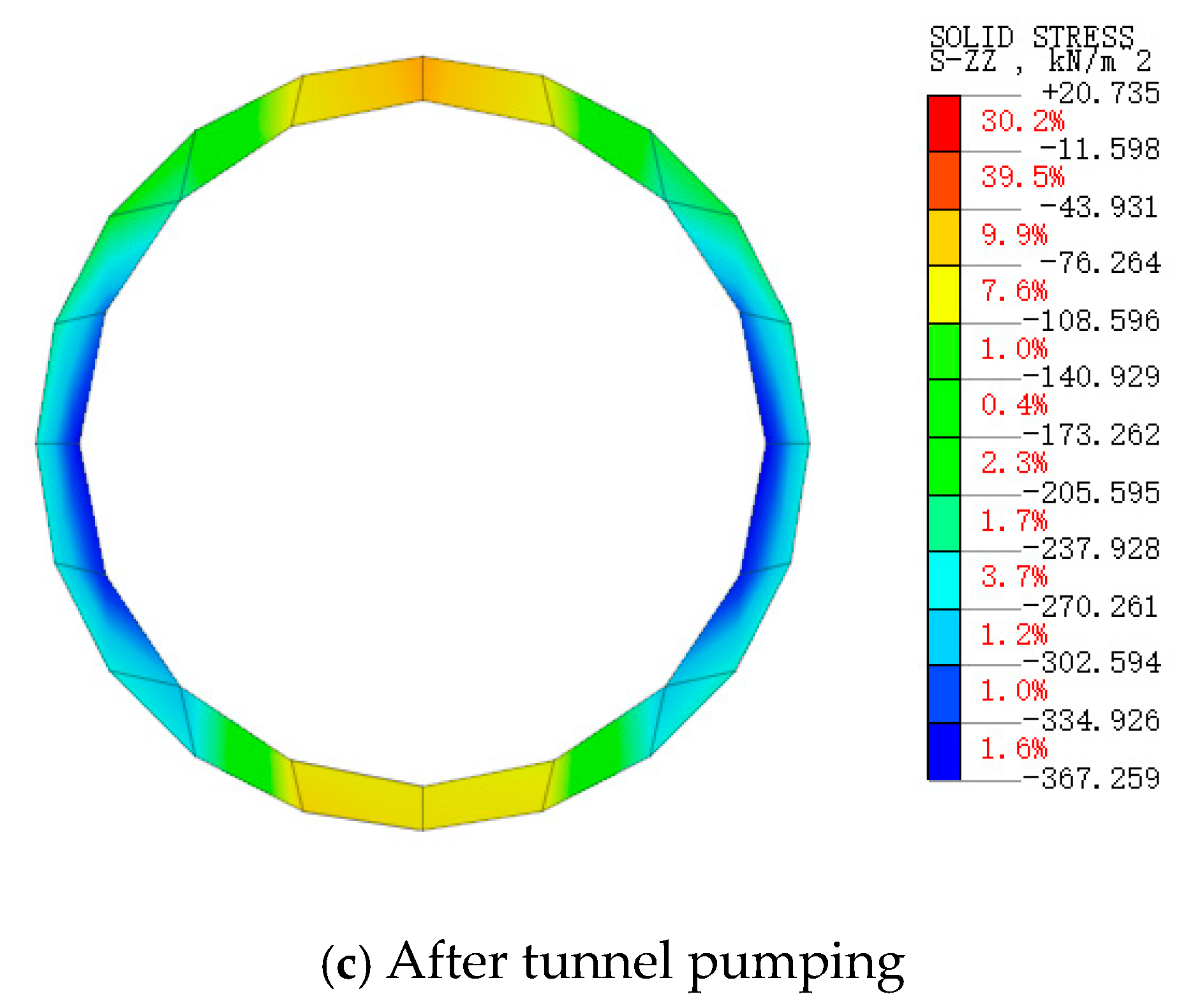
| Year | Water-Related Accident Cases | Consequences |
|---|---|---|
| 2024 | Water and Sand Inrush in Xi’an Metro Line 8 | Road subsidence, followed by collapse. |
| 2024 | Water and Sand Inrush at the Construction Site of Wuhan Metro Line 12 | Large-scale road settlement caused the suspension of the Xiao-Wu Intercity Railway. |
| 2019 | Water Inrush in Kolkata Metro, India | Surrounding buildings were severely damaged or collapsed, threatening the lives and property of residents. |
| 2017 | Groundwater Inrush into Tunnel in Seoul, South Korea | Severe water accumulation inside the tunnel caused ground settlement and collapse. |
| Soil Layer | E/kPa | Moisture Content/% | Poisson’s Ratio v | γ/(kN·m−3) | C /kPa | /(°) | Initial Pore Ratio |
|---|---|---|---|---|---|---|---|
| Miscellaneous fill | 31,500 | 21.0 | 0.27 | 18.6 | 4.0 | 10.0 | 0.610 |
| sandy soil | 31,200 | 17.8 | 0.28 | 20.1 | 14.9 | 21.3 | 0.618 |
| sandy soil | 31,500 | 18.5 | 0.30 | 19.4 | 16.0 | 24.0 | 0.617 |
| silty clay | 32,100 | 20.6 | 0.28 | 19.3 | 20.0 | 16.0 | 0.658 |
| clayey silt | 31,800 | 19.3 | 0.29 | 19.3 | 17.0 | 23.0 | 0.634 |
| silty clay | 32,400 | 21.0 | 0.32 | 19.4 | 22.0 | 16.0 | 0.668 |
| silty clay | 32,700 | 21.3 | 0.30 | 19.5 | 23.0 | 15.8 | 0.672 |
| sandy soil | 32,400 | 21.8 | 0.30 | 19.4 | 26.0 | 16.1 | 0.671 |
Disclaimer/Publisher’s Note: The statements, opinions and data contained in all publications are solely those of the individual author(s) and contributor(s) and not of MDPI and/or the editor(s). MDPI and/or the editor(s) disclaim responsibility for any injury to people or property resulting from any ideas, methods, instructions or products referred to in the content. |
© 2024 by the authors. Licensee MDPI, Basel, Switzerland. This article is an open access article distributed under the terms and conditions of the Creative Commons Attribution (CC BY) license (https://creativecommons.org/licenses/by/4.0/).
Share and Cite
Wang, Z.; Dong, J.; Zhao, Y.; Wang, Z. Analysis of Fluid–Structure Coupling of Sudden Water Deformation in Tunnels Under Construction. Water 2024, 16, 3479. https://doi.org/10.3390/w16233479
Wang Z, Dong J, Zhao Y, Wang Z. Analysis of Fluid–Structure Coupling of Sudden Water Deformation in Tunnels Under Construction. Water. 2024; 16(23):3479. https://doi.org/10.3390/w16233479
Chicago/Turabian StyleWang, Zhongkai, Jinyu Dong, Yawen Zhao, and Zhongnan Wang. 2024. "Analysis of Fluid–Structure Coupling of Sudden Water Deformation in Tunnels Under Construction" Water 16, no. 23: 3479. https://doi.org/10.3390/w16233479
APA StyleWang, Z., Dong, J., Zhao, Y., & Wang, Z. (2024). Analysis of Fluid–Structure Coupling of Sudden Water Deformation in Tunnels Under Construction. Water, 16(23), 3479. https://doi.org/10.3390/w16233479






